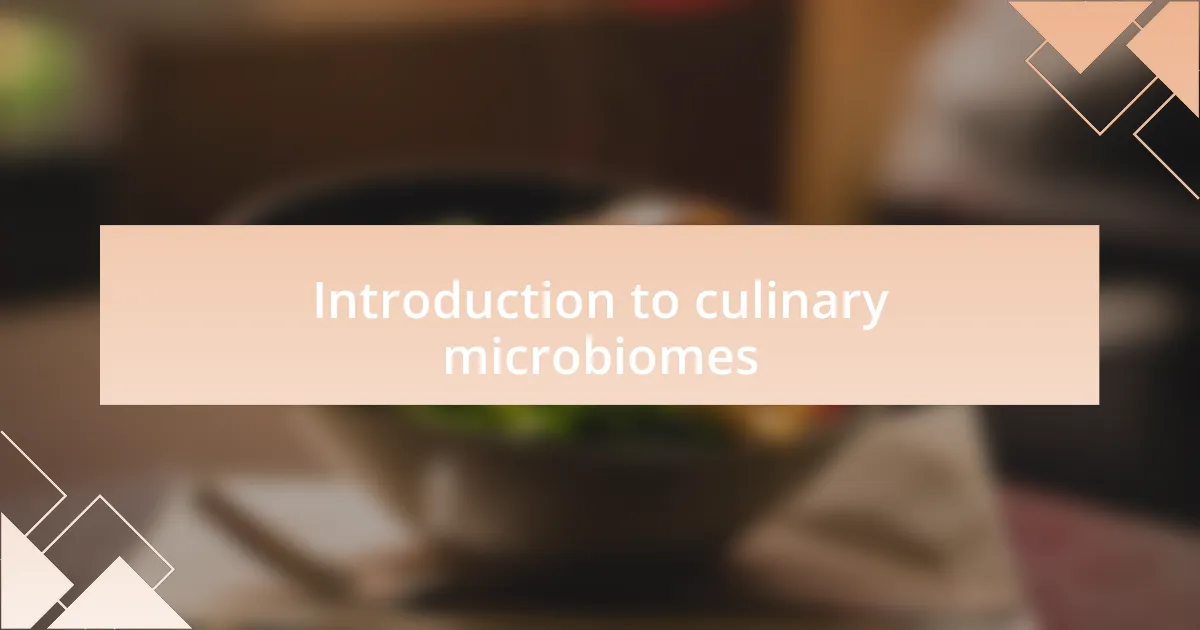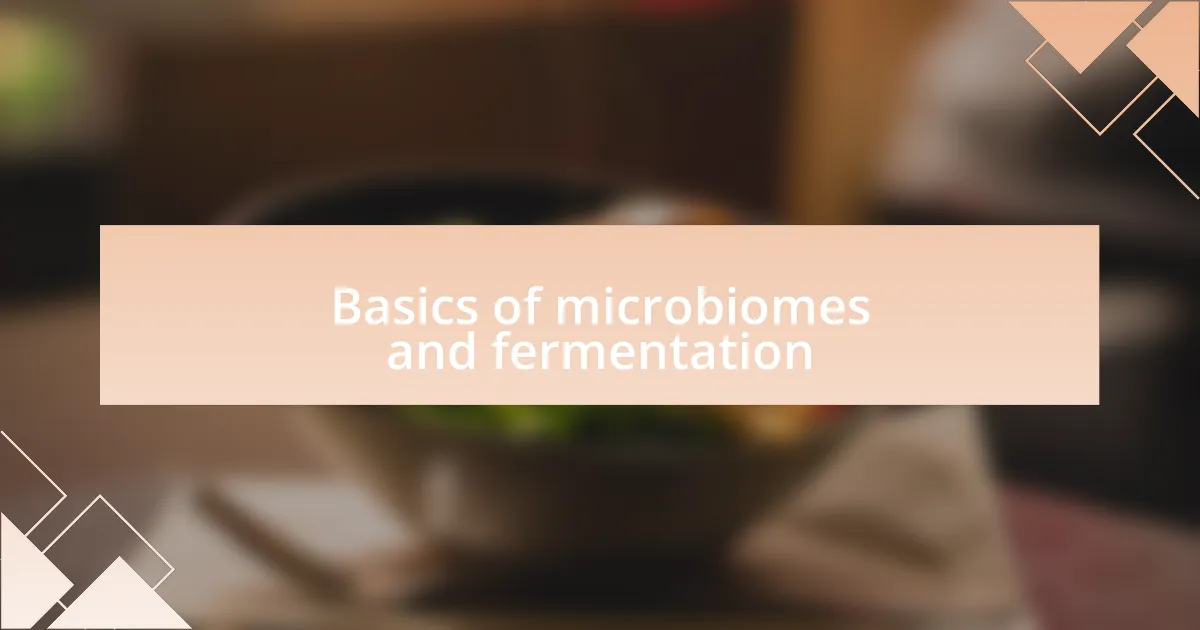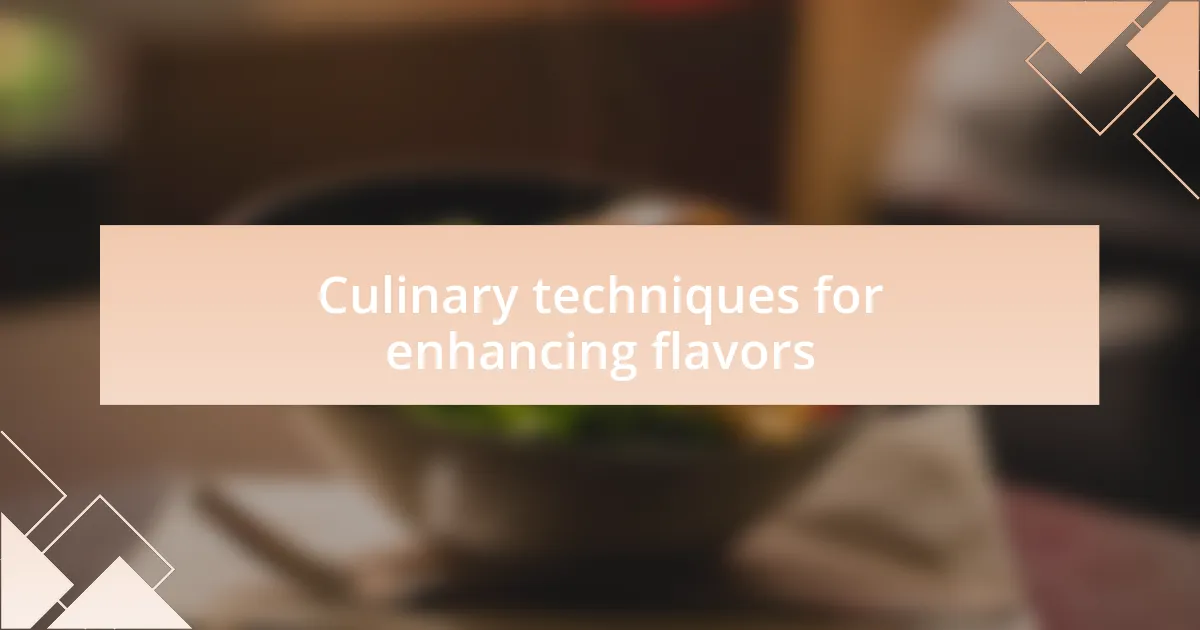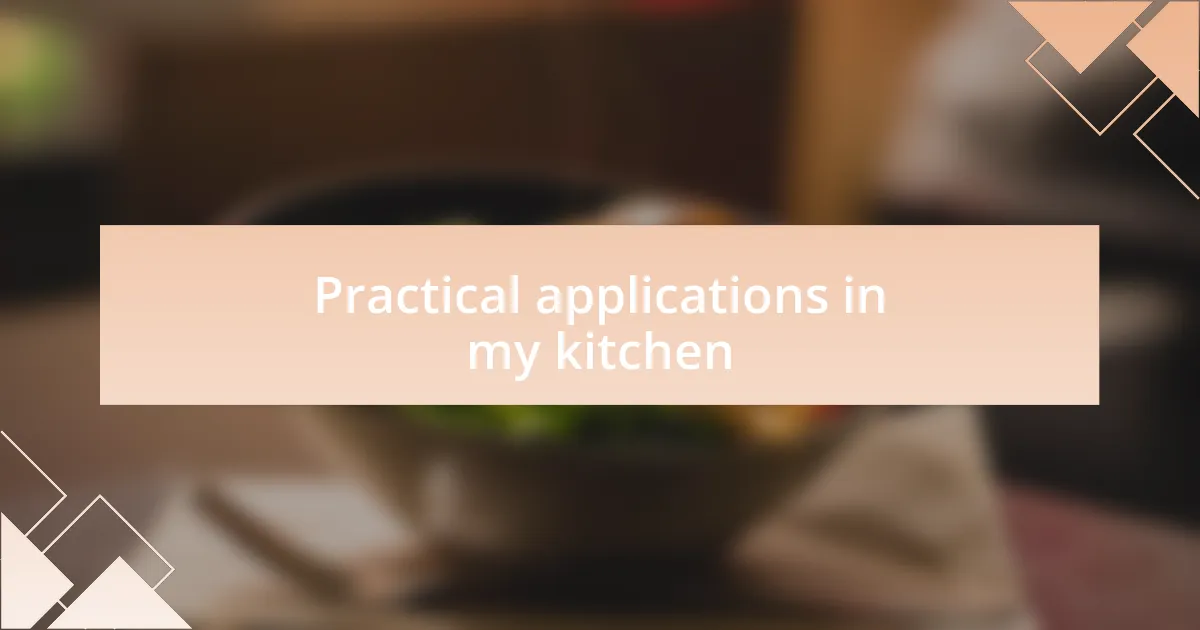Key takeaways:
- Culinary microbiomes significantly enhance flavors and nutritional benefits through fermentation, showcasing the intricate relationship between microorganisms and food.
- Experimentation and patience are essential in culinary practices, particularly when working with fermentation to achieve desired flavors and textures.
- Incorporating fermented ingredients into dishes can transform ordinary meals into extraordinary experiences, emphasizing the importance of microbial contributions to cooking.
- Community and shared learning in fermentation practices enrich the culinary journey, highlighting the collective knowledge and passion surrounding food preparation.

Introduction to culinary microbiomes
Culinary microbiomes represent a fascinating intersection of food, flavors, and science. When I first delved into the world of fermentation, I was struck by how these tiny microorganisms could transform humble ingredients into something magical. Have you ever wondered why a sauerkraut made at home tastes more vibrant than store-bought? It’s the unique blend of microbes that makes each batch distinct.
Throughout my culinary journey, I’ve come to appreciate the invisible world within our kitchens. The symbiotic relationship between bacteria, yeast, and our ingredients can lead to flavors that are complex, layered, and often surprising. For instance, experimenting with sourdough taught me that each starter carries a personality shaped by its environment. How can such microscopic entities influence the character of our food so profoundly?
Understanding culinary microbiomes isn’t just a scientific endeavor; it’s an art. This delicate balance can enhance flavors and contribute to health benefits—who knew that a bit of fermented kimchi could add both zest and a probiotic kick to your meal? As I reflect on my experiments, I’m reminded of the joy and excitement that comes from allowing nature to play its role in the kitchen, turning simple dishes into extraordinary experiences.

Basics of microbiomes and fermentation
Microbiomes play a crucial role in fermentation, acting as the unseen artists behind many of our favorite foods. I remember the first time I left a jar of cucumbers to ferment on my countertop. Each day, I eagerly checked for bubbles, feeling a mix of anticipation and curiosity—was this simple process really transforming my vegetables into tangy pickles? That slow transformation, driven by beneficial bacteria, is a magical process that showcases how alive our food truly is.
The beauty of fermentation lies in its dependability on a diverse community of microbes. While making yogurt, I noticed the subtle shift in taste and texture as different cultures interacted. It’s remarkable to think that the specific strain of bacteria, influenced by temperature and time, creates yogurt that perfectly complements whether you enjoy it sweet or savory. Isn’t it fascinating how something so delicate can yield such gratifying results?
Diving deeper into the world of culinary microbiomes, I’ve learned that the environment significantly impacts these fermentative processes. I often reflect on my experiences with brewing kombucha; my first batch turned out overly sweet because I didn’t give the yeast enough time to work. This incident taught me patience and experimentation, emphasizing how vital it is to respect the natural rhythms of fermentation. In my opinion, allowing these microbes to take their time not only enhances flavor but also fosters a deeper connection between us and the food we create.

Culinary techniques for enhancing flavors
When it comes to enhancing flavors, one of my go-to techniques is roasting. The first time I tried roasting garlic, it was a game changer. Seeing those cloves transform from pungent to sweet and caramelized made me wonder how such a simple method could elevate everyday dishes. Adding roasted garlic to sauces or spreads instantly brings a rich depth that you just can’t achieve otherwise.
Another powerful technique I love is layering flavors. After experimenting with herbs and spices, I’ve found that adding them at different stages of cooking unlocks a new dimension of taste. For instance, when I sauté onions with fresh thyme early on, then toss in a handful of basil just before serving, the dish transforms into a vibrant celebration of flavor. Have you ever noticed how the fragrance in your kitchen can tell the story of what you’re cooking?
Finally, I can’t emphasize enough the magic of acid in cooking. A splash of lemon juice or a dash of vinegar can drastically change a dish, giving it brightness and balance. I remember trying to elevate a simple pasta dish—adding a squeeze of fresh lemon at the end made it sing in a way I hadn’t anticipated. That moment taught me to always keep an acid handy; the right pinch can turn a good meal into something spectacular.

My journey in exploring microbiomes
Delving into the world of culinary microbiomes was like opening a door to a whole new realm of possibilities. I still recall the first time I experimented with fermentation at home; the sight of bubbling sauerkraut in a jar filled me with both excitement and a bit of apprehension. How could some cabbage and salt create such complex flavors? The transformation amazed me and sparked a curiosity that led me to explore the intricate relationships between bacteria and the food we cherish.
As I continued my exploration, I discovered that even the most mundane ingredients could surprise me. One day, I decided to experiment with sourdough bread, nurturing my starter for weeks. The moment I pulled a perfectly baked loaf from the oven, with all its crusty goodness, I felt an overwhelming sense of pride. The unique tang and depth of flavor in that bread was a direct result of the living organisms I had cultivated, making me realize that the balance of flavors in my cooking was not solely in my hands but also in the microbial partners in my pantry.
I often ponder how much we overlook the role of microorganisms in our daily cooking. It’s humbling to think that dishes like kimchi or yogurt owe their brilliance to these invisible helpers. Have you ever considered how a simple probiotic can enhance your dish? Each time I incorporate fermented ingredients, I’m reminded that flavor is a shared experience between the chef and the tiny organisms collaborating in the background, helping elevate our culinary creations to new heights.

Practical applications in my kitchen
In my kitchen, using culinary microbiomes has transformed the way I approach cooking. For instance, I recently influenced my pasta dishes by adding a touch of homemade miso. The savory depth it brings is profound—it’s this umami kick that elevates the simplest meal into something extraordinary. Who knew a little miso could make such a difference in my beloved tomato sauce?
One of my favorite applications has been brewing my own kefir. The first time I added kefir to my smoothies, I was hesitant. Would it overpower the flavors? To my delight, it added a subtle richness that was both creamy and tangy. Now, I can’t imagine my morning routine without it. This tiny culture not only enhances taste but also contributes to a healthier gut— a win-win!
I’ve also started incorporating fermented vegetables into salads, and the versatility astounds me. The crunch of pickled radishes or the zing from fermented carrots adds a surprise element, turning an ordinary dish into a flavor explosion. Have you tried it? Each bite is a reminder of how diverse and lively our culinary experiences can be when we embrace the hidden powers of microbiomes.

Lessons learned from culinary microbiomes
When delving into culinary microbiomes, I’ve realized that patience is key. My first attempt at fermentation felt daunting. I remember peeking into the jar every day, anxious to see if my kimchi was actually transforming. The wait taught me not only about the science behind fermentation but also about savoring the process itself. It’s almost meditative to observe how raw ingredients evolve into something vibrant and flavorful.
Understanding the balance of flavors has been a profound lesson, too. I learned this the hard way when I tried to rush the fermentation of a batch of pickles. I got overly enthusiastic and added too much garlic early on. Instead of the tangy crunch I envisioned, I created a pungent disaster. It was a humbling reminder that experimentation in the kitchen often comes with its share of failures, but each one teaches us something valuable.
I’ve also come to appreciate community in the world of microbiomes. Joining a local fermentation group opened my eyes to the collective knowledge and passion out there. Sharing successes and failures alike made the journey feel less solitary. Have you ever experienced the joy of learning with others? Connecting through our culinary adventures not only enhances our skills but also strengthens our bond with food and each other.